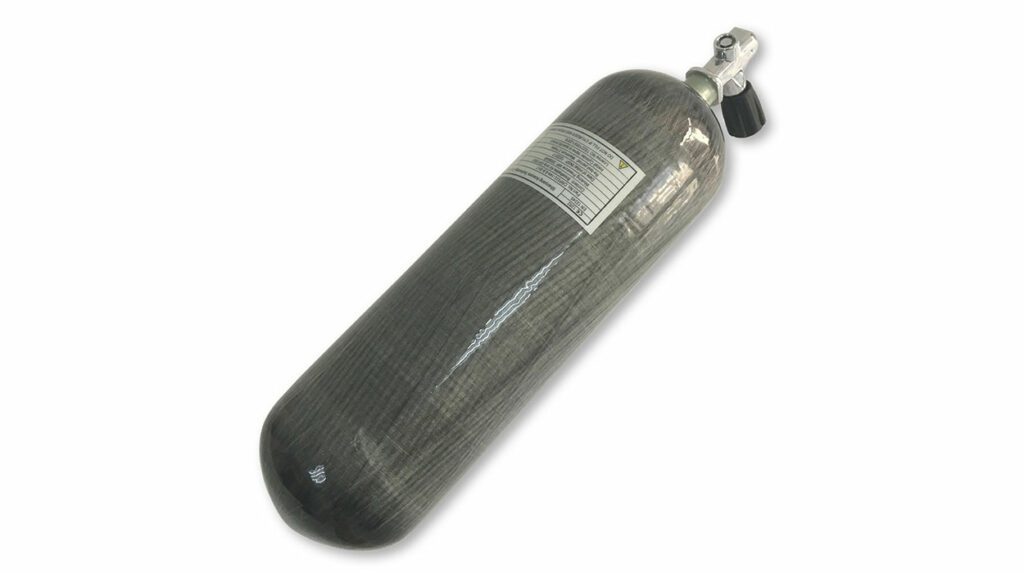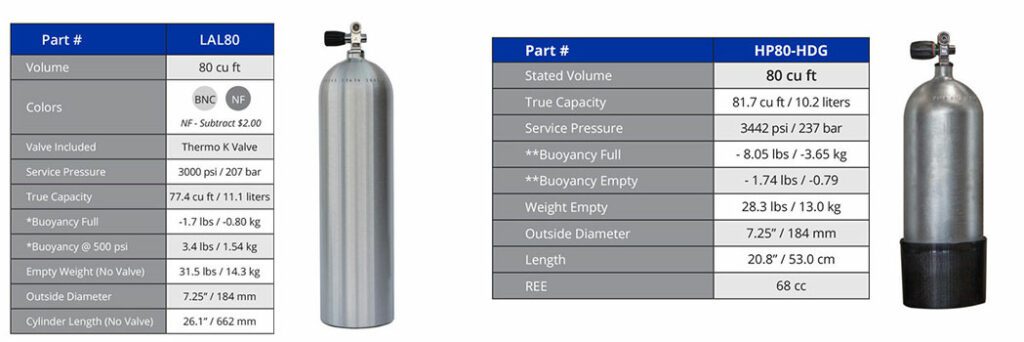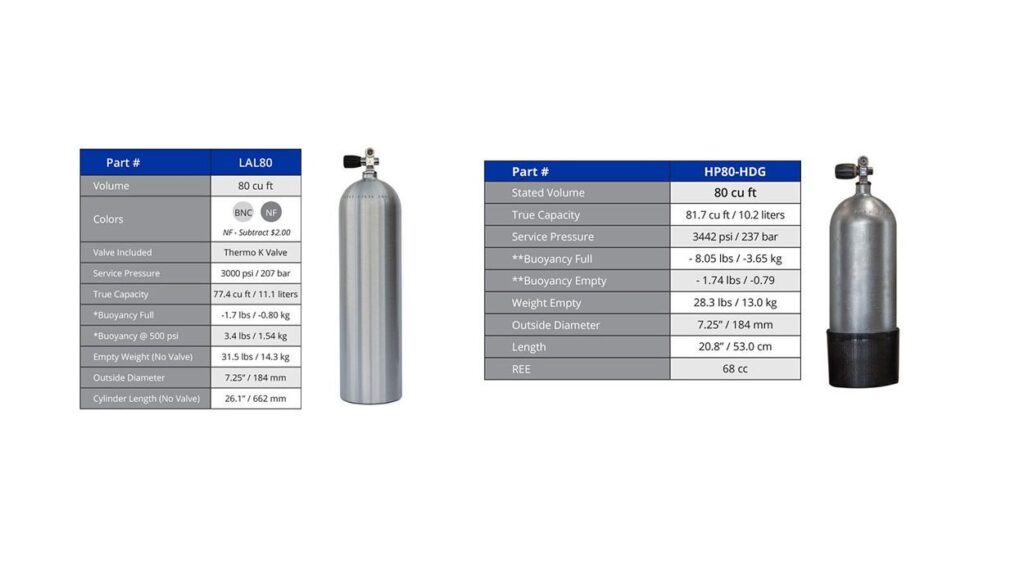A scuba diving tank is an essential piece of diving equipment. During your basic diving course, you will be using a diving cylinder with compressed air inside. But what exactly is a diving tank and how is it constructed? Today we’ll talk about this piece of diver’s equipment.
A diving cylinder is nothing more than a closed and sealed container designed to hold compressed gas. Similar to gas cylinders for stoves or those that power LPG cars. All these tanks must be designed to withstand high pressure and be resistant to damage. So let’s get to the details.
What can you find in this post?
A diving cylinder is actually a basic piece of equipment for a diver. Without it, we need neither a scuba regulator nor a BCD. However, it seems to me that often in diving courses too little attention is paid precisely to tanks. Therefore, I have prepared this text to dispel some doubts and prevailing myths about diving cylinders. Should we get started?

What material are diving tanks made of?
Let’s start with what material diving tanks are made of. I bet you will find the same type of diving cylinder in the vast majority of dive centers around the world. It will be made of aluminum alloy, and its size is 80′. We’ll get to the available sizes and the differences between these tanks in a moment, but for now let’s focus on the material.
Aluminum diving tanks
It is used to say that the cylinders we use are “aluminum”, this is of course an abbreviation, since the correct name of the material is aluminum alloy. In the case of diving tanks and, of course, also those used in our dive center, a high-strength 6061-T6 alloy is used. The main compounds used to make this alloy are aluminum, magnesium and silicone.
Steel diving tanks
An equally popular material for making diving cylinders is steel. And, of course, in this case we are also dealing with steel alloy. Depending on the standard used by the manufacturer, it can be an alloy with, for example, manganese and carbon, as well as molybdenum, zirconium, chromium, boron or nickel.
Carbon fiber diving cylinders
More as a curiosity, I must also add here diving tanks made of carbon fiber. High-pressure tanks that are made of carbon fiber have been available for several years. Initially these cylinders were designed for sports such as paintball, but products dedicated to diving are also available. As I mentioned at the beginning, I add this material here more as a curiosity and to draw a full picture of the available diving tanks. However, I have not personally tested such a solution, and among my friends there is also a lot of caution about this type of material.

Steel or aluminum diving tanks?
You already know what kind of material tanks are made of, so let’s now consider what kind you should choose if, for example, you plan to buy your own diving equipment. For a start, we’ll drop the carbon fiber ones, as I don’t trust them, so I can’t even suggest you consider them. That leaves us with aluminum and steel cylinders.
The general difference between steel and aluminum cylinders is weight and size. It may be surprising, but steel cylinders are lighter than aluminum ones. In addition, an aluminum tank is larger than a steel tank of the same capacity. This difference in weight has its pros and cons. If you use heavier cylinders, you need less ballast. This is especially helpful when diving in a dry suit, the use of which involves more ballast.
However, steel tanks have their disadvantages, which actually disqualify them from use in dive centers. First and perhaps most importantly – the price. Steel cylinders are much more expensive than aluminum ones, so buying dozens (or hundreds) of steel tanks would be an unnecessary additional cost. Secondly, steel cylinders are more susceptible to corrosion, especially in salt water, which would increase servicing and overall operating costs.
Corrosion of diving cylinders
An equally important consideration when choosing a tank is its susceptibility to corrosion. There is no perfect solution here, and with any material you have to expect progressive corrosion. Especially if the cylinders are not cared for properly. This, in turn, can lead to gas leaks and, in the worst case, to perforation of the cylinder wall. This in turn can be dangerous for the diver.
Steel diving cylinders are more prone to corrosion, especially if you use them in seawater. To make matters worse, a steel cylinder can rust not only from the outside, but also from the inside. This will happen if water or even ordinary moisture gets inside. And believe me, a steel diving tank corrodes very quickly, which is why it is so important to maintain it properly and react quickly to any minor damage.
Unfortunately, aluminum cylinders also have their disadvantages. They are more susceptible to damage compared to steel cylinders, and they are also prone to corrosion. However, with aluminum alloy, corrosion occurs in a different way, and the surface oxidizes, which can be seen by a white sediment.
How is the diving tank built?
The construction of the tank is actually very simple and it all comes down to three things. Strength, tightness, and how we can get out what we put in there before – that is the matter of the valve. Of course, in addition, we have such apsects as orings, that is, seals at the connection between the valve and the cylinder, and later at the connection between the valve and the regulator.
Regardless of whether we are dealing with a steel or aluminum cylinder, all the information can be found on its cup. But where is this cup located? For this we can make excellent use of the following illustrative picture. Each cylinder consists (from the top of the cylinder) of a neck [1], a cup [2], a shell [3] and a bottom [4].

[1] The neck of the tank is at the top and inside it there is a thread, into which we then screw the appropriate type of valve.
[2] The cup is the place where all the information related to a particular diving cylinder is placed. It is made of a thicker part of the material, and it is here that we will find the permanent markings of the cylinder.
[3] The shell of the tank can vary in size depending on the size of the cylinder and the material it is made of.
[4] The bottom of the tank is made of the thickest layer of material, as this is the part that is most vulnerable to scratches and damage from standing and moving it. We can find cylinders with rounded or flat bottoms.
Markings on the cylinder cup
At first glance, it may seem that the information on the bottle cup is a collection of random letters and numbers. However, they are very important and organized information. You will find such information as:
- Working pressure
- Hydrostatic pressure test
- Water capacity
- Weight of the cylinder
- Date of manufacture
- Date of previous technical inspection
How much does the dive tank weigh?
You already know that an aluminum tank is heavier than a steel one. But what weight are we talking about? Well, it will vary depending on the manufacturer and the material used, but let’s take one example.

Here we have two tanks of the same capacity, namely 80 cu ft. One of them is made of aluminum and weighs 14.3kg (31.5 lbs) without a valve, while the other tank is made of steel and weighs 13kg (28.3 lbs), also without a valve.
But the differences don’t end there. Both tanks have the same diameter, that is 184mm (7.25″), and the same capacity, 80 cu ft. However, the aluminum cylinder is 662mm (26.1′), while the steel one is 530mm (20.8′) high. As you can see, in order for an aluminum tank to hold the same amount of air, it must be larger. This is due to the simple fact that aluminum walls must be much thicker than steel walls.
Scuba diving cylinder valve
The most delicate and at the same time very necessary part of a diving cylinder is the valve. It is through the valve that we will pump in air or other gas and through the valve that we will be able to use its contents later. The largest number of diving cylinder failures is specifically related to the valve. There are many types of valves, but in diving we actually use two types. DIN and YOKE.
Here there is no answer, which is better or worse. Both solutions have their advantages and disadvantages. In most of the world’s diving schools, especially in warm waters, you will encounter cylinders with YOKE valves, as they are easier to use and less prone to user error.
In cold waters, on the other hand, DIN valves and regulators are more commonly used because they are more resistant to freezing. DIN valves can be also found in “armored” versions that allow cylinders to be filled to 300 bar. However, this is used more in technical than recreational diving.
Probably the best solution is a valve that has options for connecting both types of regulators. In simplest terms, the YOKE type valve has a built-in “nut” that, when unscrewed, forms a DIN valve. This solution is especially recommended for dive centers, where sometimes customers come with their own regulator and it is not always the type we use.

How to take care of a diving tank?
You already know that diving cylinders can become damaged or corroded. Since it is a very important, if not the most important part of your equipment, you need to pay special attention to the condition of your cylinder. Depending on the country, regulations may vary slightly, but the basics are the same everywhere. No dive center will fill your cylinders if they are not technically operational and do not have the necessary approvals.
Each cylinder must have a current pressure test confirmation. Such confirmation is stamped on the cup of the cylinder and must be repeated every five years. In addition, each cylinder should have confirmation of a visual inspection, which should be repeated every year. So much for the current regulations.
In addition, if you want the equipment to serve you for a long time then you need to take care of it. After each use, wash the equipment thoroughly in fresh water, including the cylinder and its valve. Check if the valve o-ring is damaged or simply worn out. This is a normal thing and this oring should simply be replaced.
If you notice that the valve knob does not move as before, or if you notice that the valve is not fully sealed, it is essential to return the tank for service. If you don’t, you will probably end up having to replace the entire valve sooner or later. In addition, a seal leak can lead to moisture inside the cylinder, which in turn will cause corrosion that is difficult to remove.
How to store diving cylinders?
Since we are already on the topic of taking care of diving cylinders, it is worth touching on the subject of their storage. I think it is obvious that our storage area must not be soggy or too hot. Keeping the cylinders somewhere outside, where they will be exposed to changing weather conditions, is certainly a bad idea. Keeping them in a dark and moldy basement will be just as bad.
So how do you properly store dive tanks? First of all, before putting the equipment for storage, properly wash and inspect everything. Check that nothing needs urgent repair. Then check the cylinder pressure. Never leave tanks empty, as this is a simple path to internal corrosion.
All tanks should have at least 50 bar of air throughout their lifespan. Outside of the service period, there is no way my tanks can be without air. Keeping the cylinder at a higher pressure will prevent anything from getting inside. It is a good idea to mark the cylinders with the date and pressure. This will make it easy for you to check the tanks for leaks after a period of storage.
Can a scuba diving cylinder explode?
Well, this is a question that I understand may send chills down your spine, but the answer is not so obvious.
NO. A dive tank in normal operation, within the approved pressure range and properly serviced, will not explode.
YES. A dive tank can explode. There are many reasons for this, and while such incidents are very rare, they are not unheard of. In recent years we have heard of at least a few explosions in which diving equipment was somehow involved. However, I would like to emphasize here that in all cases known to me the explosion involved a pure oxygen tank. It is not used for diving, but is on the boat as part of medical backup or possibly used for decompression during technical dives.
YES. A diving tank can explode in case of extreme overload. Therefore, each tank and valve has a clearly defined maximum pressure, which is further protected by a safety margin. However, in case of accidental or intentional overload during pumping, the tank can explode. Below we have a great video illustrating the testing of such an overload.
Can I carry diving cylinders on the plane?
Whether you can take your diving tanks on board depends on airline regulations. However, there are also general rules for carrying high-pressure tanks, which say that yes, you can carry them on passenger airlines, but only if the tank is completely empty and the valve is removed from the cylinder. What follows is that if you’re thinking of taking tanks with you on vacation, it’s probably not the best idea…
Can I buy a used scuba diving cylinder?
Buying any item second-hand always involves risk. You don’t know how the item was used, how it was cared for and, finally, whether it has any hidden defects. But in exchange for the risk you take, you get a lower price. That’s the theory, at least.
With diving equipment it is similar. The lower price rewards the risk taken, and I have absolutely nothing against that. In fact, if you look at it objectively, in every dive center the equipment you use was…. used. So why wouldn’t you buy used diving equipment for yourself?
Of course, you can buy used diving equipment, but in my opinion you should check it carefully. It’s not that it will be completely unusable, but that servicing can be expensive. If you’re going to buy a used dive tank, it’s best to take it to a service center so they can check it properly.
How long can I dive with one tank?
Oh, I love this question. I really do. It comes up very often in a scuba diving course or Discover Scuba Diving. And I love even more to see the looks on the faces of my students when I answer them with all sincerity that…. I don’t know. And I don’t laugh at it at all, because I understand their way of thinking. If we take an example car with its tank, we can say that it will more or less go X kilometers. So if we take a second car with similar parameters, we can say with high probability that it will drive a similar distance.
However, in diving it doesn’t work that way. Every person is different and uses air differently. I will leave aside the issue of the depth of the dive and the fact that the deeper we go, the faster we use up air. But it even depends on the day, if I’m tired, if I’m stressed about something and what the weather is like. My wife, who is also a professional diver, can be underwater with one cylinder for 2 hours. But on the other side are my students, who after 12 minutes (!!!) were already on reserve. So how long will one scuba tank last? I don’t know…
Let’s recap – scuba diving tanks
Well… that was quite a long text, which I hope brought some answers about dive tanks and how they differ from each other. If you’re thinking about buying your own cylinders, and at the same time you don’t have any intention of traveling with them by plane, it’s actually probably a good solution. Of course, it’s also important how often you dive, because if it’s one weekend a year, in my opinion, it doesn’t make much sense to buy any equipment to own.
Anyway, the most important thing is to make some bubbles! See you underwater.


